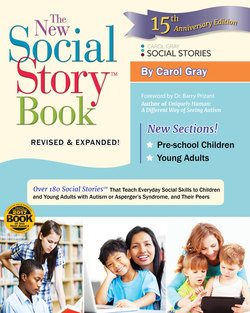Читать книгу The New Social Story Book, Revised and Expanded 15th Anniversary Edition - Carol Gray - Страница 6
На сайте Литреса книга снята с продажи.
ОглавлениеForeword
What can be said in a foreword for a new revision of Social Stories™, an update of a classic already enshrined in the annals of autism history? I’ve been focused on supporting people with autism and developmental challenges for more than four decades, so I’m going to take advantage of my seniority and reflect on my experiences and the impact of Social Stories™ over many years.
Let’s start with Carol, one of the most thoughtful, creative, and insightful educators to walk the earth (no exaggeration!!). I have had the privilege of presenting with Carol and hosting her as a conference speaker on numerous occasions. I am always in awe of her intuitive sense of how people with ASD experience the world that allows for a deep understanding of the types of knowledge and support that will be the most beneficial for them. Social Stories™ are but one of Carol’s incredible innovations that have reshaped autism education and therapy; most importantly, it all happens on a foundation of the deepest love and respect she has for people she and others support. She values them as fellow humans sharing life together, an approach often sadly missing from educational and treatment efforts.
Social Stories™ are, hands down, the most widely used “focused intervention strategy” I have observed over my many years in autism research and consulting, and in programs with differing philosophies and approaches (e.g., behavioral as well as developmental). Social Stories™ are used by parents, siblings, professionals and para-educators of all shapes and sizes in school, home and community settings. If imitation is the sincerest form of flattery, the cup runneth over for Social Stories™. Social Stories™ have been copied, modified, and sometimes re-configured to such an extent that one must carefully scrutinize whether what one claims to be a Social Story™ actually meets Carol’s specifically delineated specifications for structure and implementation. One of the most flagrant violations is when Social Stories™ are used primarily to correct behavior rather than enhance social understanding. Carol is so clear about this issue because she cares so much about the developing self-esteem of a person with developmental challenges. Of course, individualized support with a focus on building social understanding is a hallmark of Social Stories™.
Some practitioners think of Social Stories™ as simple. To the contrary, they are a strategy that is incredibly elegant when precisely formulated according to Carol’s criteria. Social Stories™ have proven to be effective in educational practice and validated in research as an essential support for persons with developmental challenges and differences of all ages and a wide range of developmental abilities. In fact, in this latest revision, Carol has added two chapters of Stories for preschoolers (an entire one devoted to using the toilet), as well as expanding each chapter and adding a collection of Social Articles for adults.
Yes, Social Stories™ may be described as an effective and meaningful approach to support social understanding, but the ultimate and deeper goal is to empower children and older people by enhancing their understanding of social situations and social encounters in their lives, and thereby supporting their ability to be active participants in life’s routines and activities. The effective use of Social Stories™ goes even further—it allows practitioners and parents to build trusting relationships through their support. Ultimately, the overarching goal of Social Stories™ is this: to help people to be self-determined, confident and competent individuals.
So now, dig in, enjoy and show the people you are teaching and supporting how much you love and care about them through your use of Social Stories™. Your efforts will help them thrive and live happily in this crazy world of ours.
BARRY M. PRIZANT, PH.D., CCC-SLP
Adjunct Professor
Artists and Scientists as Partners Group
Brown University
Director, Childhood Communication Services
Cranston, RI
Co-Developer, the SCERTS® Model Author: Uniquely Human: A Different Way of Seeing Autism
